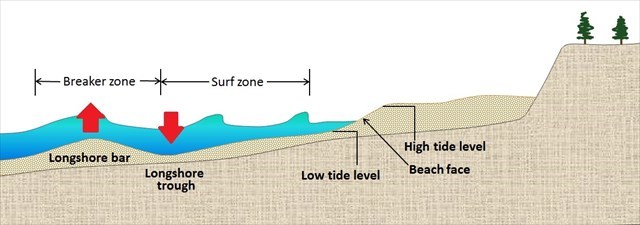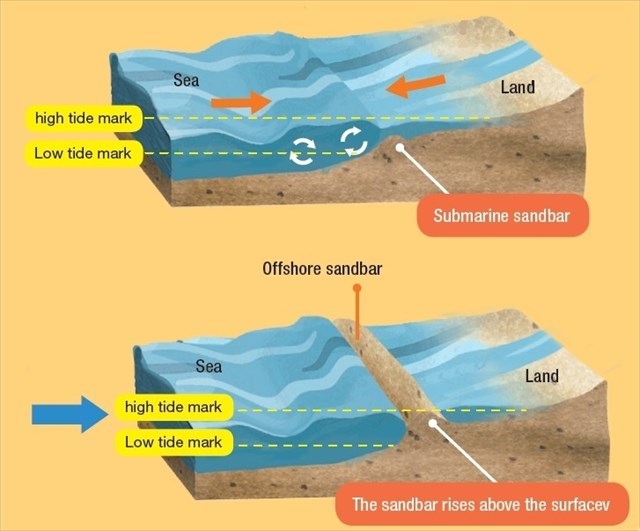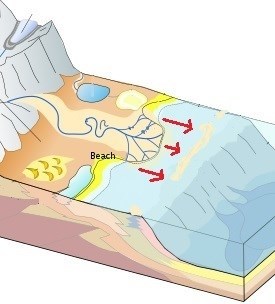
Umbrella Sandbar is located about 10 kilometers from the coast of Chiayi County and currently covers an area of more than 100 hectares. It is named after its umbrella shape and is the largest sandbar in Taiwan.
Of interest is the fact that this chunk of land is continually moving its location. It drifts an average of 60-70 meters per year, so that over the decades maps have been redrawn and local municipalities have disputed its jurisdiction.
This earth cache requires you to visit Umbrella Sandbar, observe your surroundings, take compass readings, and use your findings to answer some questions.
What are sandbars?
Sandbars are usually found off ocean coasts and river banks. They are a type of depositional landform. This means that the landform is created by deposits of materials such as rocks, sand, shells, and other sediment.
Other types of depositional landforms are beaches, deltas, glacial moraines, sand dunes and salt domes.
What moves the materials to make these landforms?
The deposited materials are usually transported by flowing ice or water, such as oceans, rivers, and glaciers. Wind and gravity also play a part.
Such landforms can change their shapes over a relatively short period of time if the process that caused the buildup is recent and still going on. This is the case with Umbrella Sandbar.
How are ocean sandbars formed?
Waves and ocean currents play a big part. Waves transport materials such as sand, rocks, shells and dirt and drop them to form both underwater and above-surface landforms.

When a wave forms and breaks, it will pick up sand from the sea floor. This will create a trough in the sandy bottom, as well as move the sand. Some of this sand is carried forward by the wave onto the coastline (beach).
However, as the wave breaks forward, the turbulence under the wave carries sand in the opposite direction as well. This sand will be deposited away from the shoreline, behind where the waves form and break. Ocean rip currents will also add material to the offshore sandbar formation.

In short, with each wave more sand is carried away from the ocean floor and deposited away from the shoreline. The troughs created in the sea floor by the waves help to separate the coast from the sandbars even more.
Is this how Umbrella Sandbar was formed?
Yes, but there's more.
While the movement of the ocean played a major part in creating Umbrella Sandbar, another important factor was alluvial deposits. Alluvial deposits are materials carried by rivers. As a river flows, the water movement picks up sand and rocks from its channel and then deposits the sediment as the river empties into the ocean.

So Umbrella Sandbar was also created by large amounts of sediment carried by a river when it goes out to sea.
Why is it moving?
Historical records show that Umbrella Sandbar started forming at the end of the 19th century, during the early years of the Japanese occupation of Taiwan. Maps from 1901 place the sandbar in a different location than today. The movement of sand by waves and tides, as explained above, is one reason.
Another reason is the wind. While the ocean builds and moves the sandbar from below, winds blow and transport the sand from above.

The regular monsoon winds in the Taiwan Strait is another reason Umbrella Sandbar has moved from its original location in a relatively short time.
How to log this earth cache
You will need to complete some tasks and answer questions based on those tasks. The information above about waves & tides, alluvial deposits, and wind will help you. Be sure to have a compass!
Task 1: When you arrive at the sandbar, look at your compass to determine which side of the sandbar you're on. Observe any waves and ocean movement where you are.
Now walk across the narrow width of the sandbar to the other side (it should take only 5-10 minutes). Look at your compass to determine which side of the sandbar you're on now. Observe any waves and ocean movement where you are.
Question 1: Based on your compass readings and your observation of the waves, in which direction has Umbrella Sandbar been moving, east or west? Refer to the above information as to how waves deposit the sand.
Task 2: Use your compass and observe in which direction the wind is blowing the sand.
Question 2: Based on your observation of the blowing sand, in which direction has Umbrella Sandbar been moving, north or south?
Task 3: Take a look at the map below of the current locations of Taiwan's rivers and Umbrella Sandbar:

When Umbrella Sandbar was beginning to form 120+ years ago, it was not located where it is today. Alluvial deposits from a nearby river mouth contributed a lot of the material to create the sandbar.
Question 3: Based on the direction the sandbar has moved over the last century (refer to your answer from question 2), which river contributed alluvial deposits to form Umbrella Sandbar in its early formation? Zhuoshui River 濁水溪, Beigang River 北港溪, or Zengwen River 曾文溪?
Task 4: You must visit the earth cache location to claim a find. The cache waypoints show the location of the boat ticket office.
To verify your visit, please take a photo on the sandbar. The photo must contain either you (no face required), your personal item, your geocaching name, a screenshot of your gps location, or anything else that would make your photo unique. A couple of samples are below:


Note:
- Please don’t post any answers in your log.
- Please send your answers to the cache owner (me) via geocaching.com's message system. If found as a group, each geocaching account name should send the answers in order to log a find.
- You may log your find as soon as you send the answers. You don't need to wait for my permission. If there are any problems I will contact you.
- Any logs without answers submitted, or logs from "armchair" visitors, will be deleted.